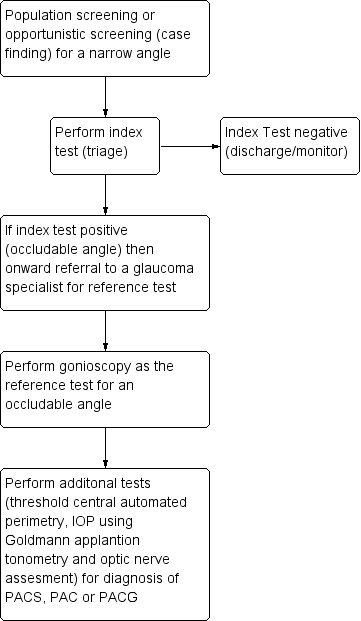| DOMAIN | LOW | HIGH | UNCLEAR |
| PARTICIPANT SELECTION | Describe methods of participant selection; describe included participants (prior testing, presentation, intended use of index test and setting) |
| Was a consecutive or random sample of participants enrolled? | Consecutive sampling or random sampling of people according to inclusion criteria | Non‐consecutive cohort of referrals (from primary care) or (in screening setting) sampling based on volunteering or referral | Unclear whether consecutive or random sampling used |
| Was a case‐control design avoided? | No selective recruitment of people with or without narrow angles, or nested case‐control designs (systematically and randomly selected from a defined population cohort) | Selection of either cases or controls in a predetermined, non‐random fashion; or enrichment of the cases from a selected population | Unclear selection mechanism |
| Did the study avoid inappropriate exclusions? | Exclusions are detailed and felt to be appropriate (e.g. people with corneal opacities, known ocular malformation or disease causing bulbar derangement) | Inappropriate exclusions are reported (e.g. of people with borderline index test results) | Exclusions are not detailed (pending contact with study authors) |
| Risk of bias: could the selection of participants have introduced bias? | All signalling questions = ‘Yes’ | Any signalling question = ‘No’ | Unclear |
| Concerns regarding applicability: are there concerns that the included participants do not match the review question? | Inclusion of participants without a previous diagnosis of a narrow angle | Inclusion of participants with a previous diagnosis of a narrow angle | Unclear inclusion criteria |
| INDEX TEST | Describe the index test and how it was conducted and interpreted |
| Were the index test results interpreted without knowledge of the results of the reference standard? | Test performed “blinded” or “independently and without knowledge of” reference standard results are sufficient and full details of the blinding procedure are not required; or clear temporal pattern to the order of testing that precludes the need for formal blinding | Reference standard results were available to those who conducted or interpreted the index tests | Unclear whether results are interpreted independently |
| If a threshold was used, was it prespecified? | The study authors declare that the selected cut‐off used to dichotomise data was specified a priori; or a protocol is available with this information | A study is classified at higher risk of bias if the authors define the optimal cut‐off post hoc, based on their own study data | No information on preselection of index test cut‐off values |
| Risk of bias: could the conduct or interpretation of the index test have introduced bias? | All signalling questions = ‘Yes’ | Any signalling question = ‘No’ | Unclear |
| Concerns regarding applicability: are there concerns that the index test, its conduct or interpretation differ from the review question? | Tests used and testing procedure clearly reported and tests executed by personnel with sufficient training | Tests used are not validated or study personnel was insufficiently trained | Unclear execution of the tests or unclear study personnel profile, background and training |
| REFERENCE STANDARD | Describe the reference standard and how it was conducted and interpreted |
| Is the reference standard likely to correctly classify the target condition? | Not applicable. Score ‘Yes’ for all studies |
| Were the reference standard results interpreted without knowledge of the results of the index test? | Reference standard performed “blinded” or “independently and without knowledge of” index test results are sufficient and full details of the blinding procedure are not required; or clear temporal pattern to the order of testing that precludes the need for formal blinding | Index test results were available to those who conducted the reference standard | Unclear whether results were interpreted independently |
| Risk of bias: could the reference standard, its conduct or its interpretation have introduced bias? | All signalling questions = ‘Yes’ | Any signalling question = ‘No’ | Unclear |
| Concerns regarding applicability: are there concerns that the target condition as defined by the reference standard does not match the review question? | Not applicable. Score ‘Yes’ for all studies |
| FLOW AND TIMING | Describe any participants who did not receive the index test(s) or reference standard, or either, or who were excluded from the 2 x 2 table (refer to study flow diagram); describe the time interval and any interventions between index test(s) and reference standard |
| Was there an appropriate interval between index test(s) and reference standard? | No more than three months between index and reference test execution | More than three months between index and reference test execution | Unclear whether test results were executed within three months |
| Did all participants receive a reference standard? | All participants receiving the index test were verified with the reference standard | Not all participants receiving the index test were verified with the reference standard | Unclear whether all participants receiving the index test were verified with the reference standard |
| Did all participants receive the same reference standard? | Not applicable. Score ‘Yes’ for all studies |
| Were all participants included in the analysis? | The number of participants included in the study match the number in analysis | The number of participants included in the study does not match the number in analysis | Insufficient information on whether the number of participants included in the study matches the number in analysis |
| Risk of bias: could the participants' flow through the study have introduced bias? | All signalling questions = ‘Yes’ | Any signalling question = ‘No’ | Unclear |


